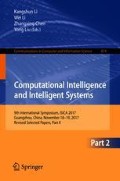Abstract
Based on two-domain DNA strand displacement, a computing model is proposed. The model is used as a “referee” for two players in a well-known Rock-Paper-Scissors game, which can be utilized as an example of the study of game theory and artificial intelligence (AI). A molecular model based on Two-domain strand displacement is applied to emulate the process of the game. The output of the circuit shows the final result of the underlying game, that is, each player’s win, lose and draw. The two players hold a win of one inning and two win of three innings which are simulated by employing Visual DSD software. The simulation results show that the molecular model is correct and feasible. The establishment of the computing model is hoped to provide some new insights for the AI in the field of nanotechnology.
Access this chapter
Tax calculation will be finalised at checkout
Purchases are for personal use only
References
Seeman, N.C.: Nucleic acid junctions and lattices. J. Theor. Biol. 99(2), 237–247 (1982)
Mccarthy, J., Minsky, M.L., Rochester, N., Shannon, C.E.: A proposal for the Dartmouth Summer research project on arterial intelligence. J. Mol. Biol. 278(1), 279–289 (2006)
Stefan, N., Katy, B., Nafisi, P.M., Kathy, T., John, G., Douglas, S.M.: Folding complex dna nanostructures from limited sets of reusable sequences. Nucleic Acids Res. 44(11), 102–108 (2016)
Scheible, M.B., Pardatscher, G., Kuzyk, A., Simmel, F.C.: Single molecule characterization of DNA binding and strand displacement reactions on lithographic DNA origami microarrays. Nano Lett. 14(3), 1627–1633 (2015)
Han, D.G., Pal, S., Nangreave, J., Deng, Z.T., Liu, Y., Yan, H.: DNA origami with complex curvatures in three-dimensional space. Science 6027(332), 342–346 (2011)
Zhang, C., Yang, J., Jiang, S.X., Liu, Y., Yan, H.: DNAzyme-based logic gate-mediated DNA self-assembly. Nano Lett. 16(1), 736–741 (2016)
Wang, Z.C., Huang, D.M., Meng, H.J., Tang, C.P.: A new fast algorithm for solving the minimum spanning tree problem based on DNA molecules computation. Bio Systems 114(1), 1–7 (2013)
Wang, Z.C., Tan, J., Huang, D.M., Ren, Y.C., Ji, Z.W.: A biological algorithm to solve the assignment problem based on DNA molecules computation. Appl. Math. Comput. 244(2), 183–190 (2014)
Adleman, L.M.: Molecular computation of solutions to combinatorial problems. Science 266(5187), 1021–1024 (1994)
Chen, Y.Q., et al.: A DNA logic gate based on strand displacement reaction and rolling circle amplification, responding to multiple low-abundance DNA fragment input signals, and its application in detecting miRNAs. Chem. Commun. 51(32), 6980–6983 (2015)
Zhang, C., Ma, L.N., Dong, Y.F., Yang, J., Xu, J.: Molecular logic computing model based on DNA self-assembly strand branch migration. Sci. Bull. 58(1), 32–38 (2013)
Rogers, W.B., Manoharan, V.N.: DNA nanotechnology. Programming colloidal phase transitions with DNA strand displacement. Science 347(6222), 639–642 (2015)
Sawlekar, R., Montefusco, F., Kulkarni, V.V., Bates, D.G.: Implementing nonlinear feedback controllers using DNA strand displacement reactions. IEEE Trans. Nanobiosci. 15(5), 443–454 (2016)
Zhu, J.B., Zhang, L.B., Zhou, Z.X., Dong, S.J., Wang, E.K.: Aptamer-based sensing platform using three-way DNA junction-driven strand displacement and its application in DNA logic circuit. Anal. Chem. 86(1), 312–316 (2014)
Lakin, M.R., Stefanovic, D.: Supervised learning in adaptive DNA strand displacement networks. ACS Synth. Biol. 5(8), 885–897 (2016)
Cardelli, L.: Two-domain DNA strand displacement. Math. Struct. Comput. Sci. 26(2), 247–271 (2010)
Cardelli, L.: Strand algebras for DNA computing. Nat. Comput. 10, 407–428 (2009)
Acknowledgment
This work is supported by the National Natural Science Foundation of China (Nos. 61425002, 61751203, 61772100, 61702070, 61672121, 61572093), Program for Changjiang Scholars and Innovative Research Team in University (No.IRT15R07), the Program for Liaoning Innovative Research Team in University (No.LT2015002), and the Program for Liaoning Key Lab of Intelligent Information Processing and Network Technology in University.
Author information
Authors and Affiliations
Corresponding author
Editor information
Editors and Affiliations
Rights and permissions
Copyright information
© 2018 Springer Nature Singapore Pte Ltd.
About this paper
Cite this paper
Xie, W., Zhou, C., Fang, X., Yin, Z., Zhang, Q. (2018). Rock-Paper-Scissors Game Based on Two-Domain DNA Strand Displacement. In: Li, K., Li, W., Chen, Z., Liu, Y. (eds) Computational Intelligence and Intelligent Systems. ISICA 2017. Communications in Computer and Information Science, vol 874. Springer, Singapore. https://doi.org/10.1007/978-981-13-1651-7_30
Download citation
DOI: https://doi.org/10.1007/978-981-13-1651-7_30
Published:
Publisher Name: Springer, Singapore
Print ISBN: 978-981-13-1650-0
Online ISBN: 978-981-13-1651-7
eBook Packages: Computer ScienceComputer Science (R0)

